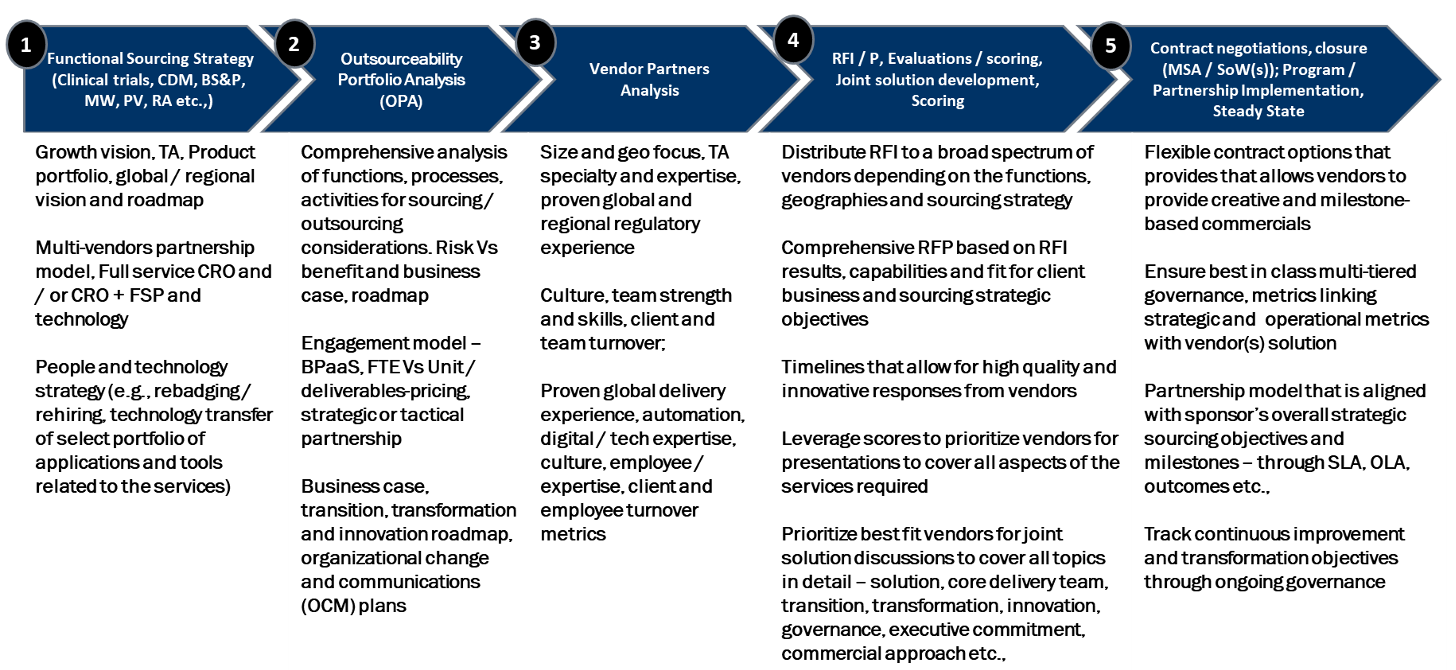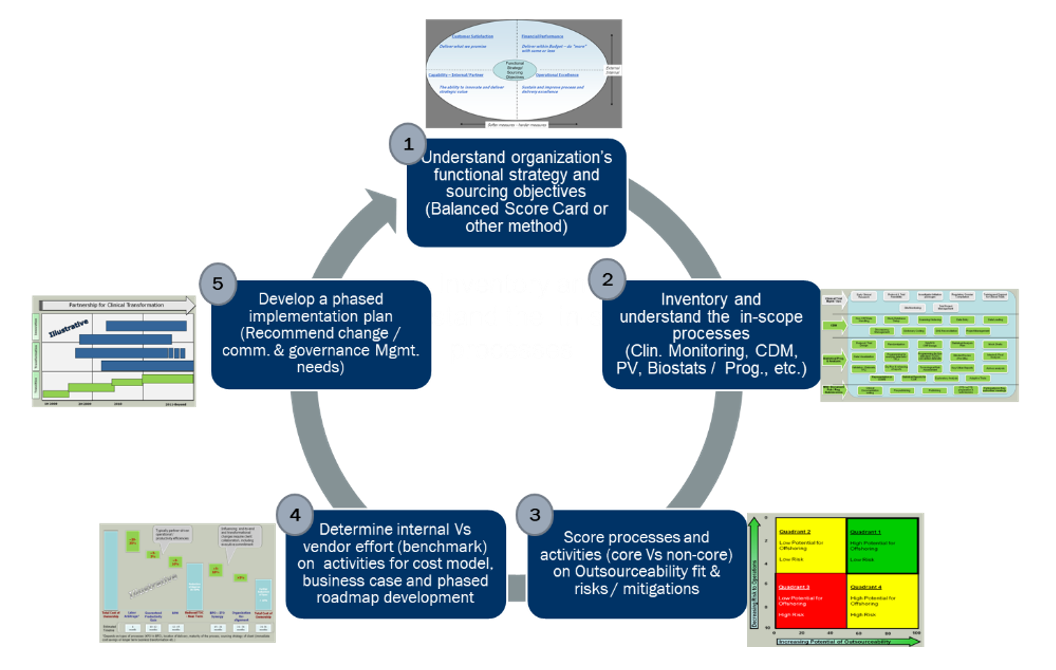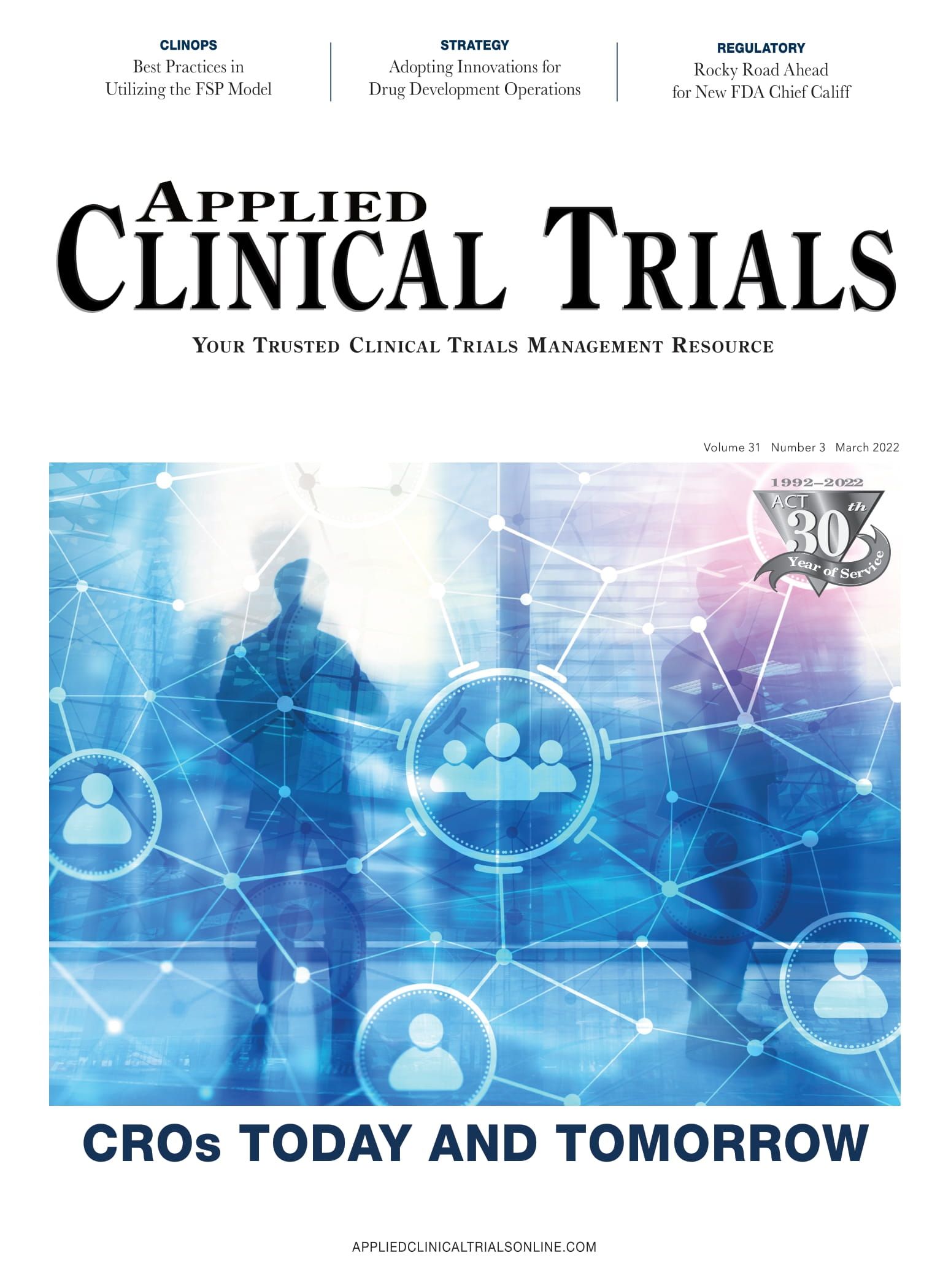Getting the Most From FSP Model
Examining best practices in using the functional service provider model for clinical operations, pharmacovigilance, regulatory, and other areas.
The pandemic has shown that there’s a lot more flexibility in clinical trial systems than what was realized in the past. It has been a catalyst in speeding the digital process, making virtual trial conduct becoming a reality. The FDA has also given the green light to shift clinical trial conduct to a virtual setting where possible to maintain patient safety with better monitoring.1 To continue the momentum, life sciences companies need to have a dependable set of global and regional external partnerships that are flexible and scalable. These partnership models (e.g., CROs and FSPs) need to fit the diverse needs of small, medium, and large companies and a variety of “future-ready” operating models that can span clinical operations and associated functions (e.g., PV, regulatory).
Overview of the FSP model
As the name indicates, the FSP model describes the engagement model utilized by sponsors with partner(s) to outsource either most of a function’s activities or a limited set of activities. The engagement model can be either FTE (cost of resource/hour) or unit/deliverables based (e.g., number of Case Report Forms (CRF), Tables, Listings, Figures (TLF), PV cases, and number of visits). In an environment where sponsors are challenged to manage their staffing capacity, with a broad set of skills needed in the face of dynamically changing clinical study or PV case volumes, the flexibility and scalability of the FSP model allows sponsors to manage the demand more effectively. This can allow them not only to expand the number of studies, therapeutic areas and innovative operating models, but also drive innovation and transformation in collaboration with their FSP partners and/or in a hybrid model with other CRO partners.
There was a misconception in the industry that FSP model is only a staff supplementation model, but this has been overcome by the positive experiences in leveraging them beyond just staff augmentation.2 Strategic investments by FSP vendors to advance their domain and operational expertise, leveraging of automation, six sigma approaches, digital technologies, and implementation of proprietary collaborative platforms to deliver 24x7 globally integrated services has allowed more and more sponsors to establish strategic partnership with FSP vendors.3 This has allowed the model to deliver on unit or deliverables-based engagement models (not just rate card/FTE/hour) and commit to continuous improvement, innovation, and transformation objectives of sponsors for the function being outsourced
Increased adoption of decentralized clinical trials, AI/ML platforms, and remote/centralized monitoring is allowing the FSP partnerships to be increasingly more strategic and part of the overall business and sourcing strategy. Some of these and other aspects leading to the rise of FSP outsourcing in drug development has been shared by other experts as well.3
Key functions and sub-functional areas within clinical development that have been outsourced as part of FSP model are outlined below:
- Clinical monitoring (CM)
- Clinical data management (CDM)
- Biostatistics, statistical programming (BS&P), data standards, conversions (e.g., CDISC)
- Medical writing (MW)
- Pharmacovigilance/drug safety (PV)
- Regulatory affairs (RA)
Based on our experience in advising clients and providing FSP/CRO services over the past 20 years, we have seen the creative bundling of some of these functions as part of the extended FSP partnership model.
- Combination of CDM, BS&P and data conversions
- Extension of the CDM, BS&P and MW into a “clinical data services’ package
- Combination of clinical monitoring, CDM, BS&P and medical monitoring into a “centralized monitoring team” (Potential future services)
- Combination of PV and regulatory activities due to regional synergies and submission / compliance requirements (Potential future services)
To ensure that the FSP model is strategic and provide the sustainable mode of partnership, we have shared some of the best practices below that can be leveraged and further customized as needed by sponsors:

1. Functional Sourcing Strategy: As sponsors refine their strategic plans, TA portfolio and geographical locations for product(s) launches, they need to adapt their sourcing (insource or outsource) and outsourcing plans to include FSP model as a standalone model to complement their internally sourced trial operations and technology strategy or combine it with their CRO model in a seamless fashion. They should also define their people strategy, such as potential rebadging/rehiring of duplicative skills across the function and technology to the strategic vendor(s) and if a set of applications/platforms and tools transfer will be part of the partnership as well.
Sponsors should collect past years’ (typically 1-3 years) core operational level metrics (e.g., Service Level Agreement (SLA), Operational Level Agreement (OLA)) in addition to their planned strategic business outcomes (based on their growth vision and benchmark data), to vendor(s) as part of the RFP process for ensuring transformational and customized engagement models to be negotiated.
2. Outsourceability Portfolio Analysis (OPA)2: To ensure that sponsor’s FSP plans are strategic and deliver both near- and long-term objectives, sponsors are best served by conducting a detailed OPA that provides a comprehensive mapping of processes, sub-processes and activities that are core to them (retained) and non-core (that can be outsourced to external vendor(s). This will answer “What, When, How, Where and To Whom” along with the risks and mitigations, business case, and roadmap for implementation and a clear “Outsourceability matrix”. Typically, these activities are drawn from sponsors’ SOPs to ensure accuracy in a joint-delivery model post contract. An illustrative approach for OPA is shown below:
Outsourceability Portfolio Analysis (OPA) for mapping of outsourceable activities Vs risk, business case and implementation roadmap

3. Vendor(s) – Partner(s) Analysis: Sponsors must include specific criteria as part of their evaluation of service providers for the FSP sourcing plan (some of these are also typically done during a full-service CRO outsourcing process):
- Size and geography focus of provider that needs to be aligned with the strategic plans of the sponsor (e.g., where they plan to conduct trials to meet their regulatory needs or the size of studies)
- Depth of the functional domain expertise of the process to be outsourced (e.g., CDM or biostatistics)
- Therapeutic Areas of specialty that need to be aligned with the type of studies planned by the sponsor and the regional regulatory agency relationship and demonstrated knowledge of having done successful submissions
- Culture of the provider organization and its fit with the sponsor’s own culture/or way of workings.
- Scalability and flexibility of the provider, demonstrated through past work with clients and case studies / references
- Team strength, capacity, experience with both FTE and unit/deliverables-based pricing models of delivery
- Commitment to deliver year-over-year productivity gains, using automation, digital/AI/ML technologies and other approaches
- Partnership approach to play a critical role in initiating, driving/participating in innovation and transformation initiatives of the sponsor.
- Past client and employee turnover (attrition) that should be on par or below benchmark for the same function and similar type of service.
- Executive commitment to participate actively in join governance discussions that ensures proactive monitoring and tracking of the program milestones and drive mitigatory actions, should milestones not be delivered on time, quality, and cost.
4. RFI/RFP process, joint solution development and rigorous scoring of proposals and solutions: It is critical that the RFI be distributed to a broad spectrum of vendors to ensure that there is a good list of vendors that can bring in different capabilities to provide a “complete solution”. Some examples to consider that may be specific to certain functions, are below:
- Clinical operations/monitoring: As the trials and industry drug pipeline becomes global—leveraging evolving digital and virtual trials (e.g., DCT), evolving regulatory requirements become more stringent due to increased complexity of trials, recruitment, and retention of patients from local geographies become critical, sponsors need to have an ideal mix of small / medium sized CROs and TA specialists that have in-depth experience in needed geographies, large CROs as well as FSPs (services and technology) to complete all their needs. The key is to have the “most optimal list of credible and proven” service providers from the RFI process
- Pharmacovigilance: Post-marketing PV/safety ICSR case processing has become mainstream over the past decade. With the expertise, scalability and flexibility and proven global / regional capabilities expanding for many of the service providers, parts of more complex and domain intensive activities like medical review, periodic reporting and signal management are starting to become part of the outsourced service portfolio. One of the key trends is for the major / mid-tier pharma is to have more than one service provider—with one provider covering the scalability and volume needs global needs, while the other provider(s) delivering advanced and more complex services. The sourcing process, governance, RACI (Responsible, Accountable, Consulted and Informed) matrix, contracts and governance for both of these providers have to be customized to ensure best risk-mitigated outcomes. Some of the evolving pharmacovigilance operating models have been reviewed elsewhere.4
- BS&P: Sponsors used to have a mix of multiple statistical programming vendors on a FTE/hour rate card basis, while most of the biostatistics activities were managed internally, given their criticality. More recently many of the activities across BS&P have been outsourced on a unit/deliverables-based pricing model (e.g., SAP, TF / TLG and number of SDTM conversions) and a multitude of vendors across geographies to supplement sponsors’ rapidly changing trial and resourcing needs. Some of the sponsors have used two sets of providers–one to provide scale and geographical coverage and other(s) to provide specialized services (e.g., protocol review, local regulatory discussions, and submissions)
- Regulatory Affairs (RA): Like PV, sponsors’ RA capabilities need to be global and regional with local experts available to manage the regulatory authorities’ requirements, audits and compliance needs. Many of our clients have adopted a “hub and spoke” model with their own capabilities in defined geographical “hubs” and having a set of providers manage some of the “spokes” geographies. The sourcing process, contracts, RACI, governance, and commercial models (e.g., FTE rate per hour versus per submission or per CSR pricing) require the need for a comprehensive list of vendors for a sustainable operating partnership.
- Technology strategy/activities: With the rapid evolution and increasing adoption of digital, AI/ML, cloud-based global collaborative platforms by the industry, the number of niche technology providers to the pharma industry, especially clinical space, has grown significantly in number. While many of the sponsors are building or buying major off-the-shelf platforms and tools, it is becoming a difficult proposition with many of the services being provided by multiple providers. One of the trends we have seen is the utilization of a set of CROs, FSPs and technology providers as part of an outsourced portfolio in a streamlined manner by major pharma. There are pros and cons to this approach but can be successful if time and effort is spent during the design of the joint operating model and joint-solutioning sessions with all the providers. This will ensure a risk-mitigated and sustainable partnership model for the sponsors. In some cases, sponsors have decided to have the provider utilize their own platform or their own licensed off the shelf platform to deliver the full platform and services as a Business Process As A Service (BPaaS) model and these require a full due diligence and detailed workflow before contracting. Some examples for this approach include are in CDM using proven EDC tools, ICSR using established tools like ARGUS.
- It is important to ensure that there is optimal mix, but limited number, of vendors in the final selection towards contract negotiations to avoid spending significant additional time and effort to manage too many providers. Balance is key and must align with the sponsor’s overall business strategy.
5. Contract negotiations and closure: Relative to the full-service outsourcing of trials to CROs, the design, development, joint solution, combined RACI matrix for strategic FSP model will require more up-front time and effort. Over the past 15 years, we have seen significant number of large FSP deals being contracted and delivered to the sponsor’s expectations, when they were designed with involvement of both leadership and operational members of the sponsors’ team during the joint solutioning, but also during the contract negotiations. Most recently, many of these functions are also bundled in a single FSP contract (e.g., CDM, BS&P, MW as a bundle) and in a unit/deliverables-based pricing commercial model. Hence, it is critical to ensure that the contract structure, flexibility, assumptions and dependencies, transition, transformation and innovation milestones, SLA/OLA, risks/mitigations, governance structure and identified roles and responsibilities, and any people aspects (e.g., selected re-badging of resources) are all reviewed in detail with the help of procurement/strategic sourcing team members and/or external advisors before signature. The optimal structuring of an MSA and supporting set of SOWs, based on the processes and activities can allow for an effective way of managing the FSP partnerships.
Summary
We are at an exciting stage of transformation across the pharmaceutical value chain with rapidly evolving digital and innovative operating models providing momentum. As life sciences companies expand their strategy and the number of global and regional trials, they are seeking innovative and creative partnership models and collaborations with external providers. Whether it is increased outsourcing or insourcing, the FSP model has become a strategic choice, given its flexibility, scalability and the increased control of decision making to the sponsors. Increased investments into expanded global and regional operational capabilities, broader pool of SMEs and experts, implementation of globally integrated processes, people and digital technologies for increased collaboration and ability to provide real-time insights to sponsors will continue to make this model an ideal choice for many of the life sciences companies. We anticipate the increased bundling of services and further expansion into additional pharmaceutical functions such as quality/compliance, medical affairs and other areas. These partnerships can allow life sciences clients and their teams to focus on developing and evaluating breakthrough therapies for a broader set of patients.
Krishnan Rajagopalan, PhD is the President of Life Sciences Transformation Group
References
- Four Trends In The Clinical Research Industry Propelled By The Pandemic; https://www.forbes.com/sites/forbesbusinesscouncil/2021/08/16/four-trends-in-the-clinical-research-industry-propelled-by-the-pandemic/?sh=597ccfd348b9
- Should Your Clinical Outsourcing Model Be Functional, Full-Service, Or A Hybrid FSP? Clinical Leader, August 29, 2013
- The Rise of FSP Outsourcing in Drug Development: Applied Clinical Trials-09-01-2020, Volume 29, Issue 9
- Pharmacovigilance (PV) Outsourcing — Emerging PV business models, Deloitte Development LLC, 2014

Improving Relationships and Diversifying the Site Selection Process
April 17th 2025In this episode of the Applied Clinical Trials Podcast, Liz Beatty, co-founder and chief strategy officer, Inato, discusses a number of topics around site engagement including community-based sites, the role of technology in improving site/sponsor relationships, how increased operational costs are impacting the industry, and more.